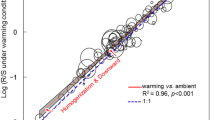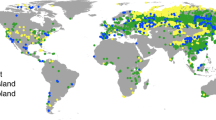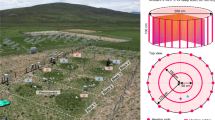Abstract
Climate warming is changing the aboveground phenology of plants around the world. However, the effects of warming on the belowground phenology of plants remain relatively under-investigated, even though roots play a vital role in carbon cycling. Here we synthesize 88 published studies to show a phenological mismatch between above- and belowground plant responses to climate warming. For herbaceous plants, warming advanced both the start and end of aboveground growing season, resulting in an unchanged growing season length. In contrast, belowground phenophases (the start, end and length of the growing season) of herbaceous plants remained unchanged. For woody plants, climate warming did not affect any aboveground phenophases but extended their belowground growing season. Mismatches between above- and belowground phenology will strongly influence biomass allocation in plants, implying that terrestrial carbon cycling models based exclusively on aboveground responses are inaccurate. The work highlights an urgent need for future research of under-represented belowground phenological changes.
This is a preview of subscription content, access via your institution
Access options
Access Nature and 54 other Nature Portfolio journals
Get Nature+, our best-value online-access subscription
$29.99 / 30 days
cancel any time
Subscribe to this journal
Receive 12 print issues and online access
$209.00 per year
only $17.42 per issue
Buy this article
- Purchase on Springer Link
- Instant access to full article PDF
Prices may be subject to local taxes which are calculated during checkout




Similar content being viewed by others
Data availability
The data used in the current study are available in the Figshare repository: https://figshare.com/s/1f086364114021cd80d959.
Code availability
The data analysis was carried out in R 3.6.1. The complete codes used to generate the results reported in this study are available in the Figshare repository: https://figshare.com/s/1f086364114021cd80d959.
References
Piao, S. et al. Characteristics, drivers and feedbacks of global greening. Nat. Rev. Earth Environ. 1, 14–27 (2020).
Forrest, J. & Miller-Rushing, A. Toward a synthetic understanding of the role of phenology in ecology and evolution. Philos. Trans. R. Soc. B 365, 3101–3112 (2010).
Lane, J. E., Kruuk, L., Charmantier, A., Murie, J. O. & Dobson, F. S. Delayed phenology and reduced fitness associated with climate change in a wild hibernator. Nature 489, 554–557 (2012).
Richardson, A. D. et al. Ecosystem warming extends vegetation activity but heightens vulnerability to cold temperatures. Nature 560, 368–371 (2018).
Abramoff, R. Z. & Finzi, A. C. Are above- and below-ground phenology in sync? New Phytol. 205, 1054–1061 (2015).
Piao, S. et al. Plant phenology and global climate change: current progresses and challenges. Glob. Change Biol. 25, 1922–1940 (2019).
Smithwick, E., Lucash, M. S., Mccormack, M. L. & Sivandran, G. Improving the representation of roots in terrestrial models. Ecol. Model. 291, 193–204 (2014).
Warren, J. M. et al. Root structural and functional dynamics in terrestrial biosphere models – evaluation and recommendations. New Phytol. 205, 59–78 (2015).
Ma, H., Mo, L., Crowther, T. W., Maynard, D. S. & Zohner, C. M. The global distribution and environmental drivers of aboveground versus belowground plant biomass. Nat. Ecol. Evol. 5, 1110–1122 (2021).
Neumann, R. B. & Cardon, Z. G. The magnitude of hydraulic redistribution by plant roots: a review and synthesis of empirical and modeling studies. New Phytol. 194, 337–352 (2012).
Lucas, M., Schlueter, S., Vogel, H.-J. & Vetterlein, D. Roots compact the surrounding soil depending on the structures they encounter. Sci. Rep. 9, 16236 (2019).
Oades, J. M. The role of biology in the formation, stabilization and degradation of soil structure. Geoderma 56, 377–400 (1993).
Thackeray, S. J. et al. Phenological sensitivity to climate across taxa and trophic levels. Nature 535, 241–245 (2016).
Roslin, T., Anto, L., Hllfors, M., Meyke, E. & Ovaskainen, O. Phenological shifts of abiotic events, producers and consumers across a continent. Nat. Clim. Change 11, 241–248 (2021).
Radville, L., McCormack, M. L., Post, E. & Eissenstat, D. M. Root phenology in a changing climate. J. Exp. Bot. 67, 3617–3628 (2016).
Blume-Werry, G., Jansson, R. & Milbau, A. Root phenology unresponsive to earlier snowmelt despite advanced above‐ground phenology in two subarctic plant communities. Funct. Ecol. 31, 1493–1502 (2017).
Wilson, J. B. A review of evidence on the control of shoot:root ratio, in relation to models. Ann. Bot. 61, 433–449 (1988).
Schwieger, S., Kreyling, J., Milbau, A. & Blume-Werry, G. Autumnal warming does not change root phenology in two contrasting vegetation types of subarctic tundra. Plant Soil 424, 145–156 (2018).
Liu, H., Lu, C., Wang, S., Ren, F. & Wang, H. Climate warming extends growing season but not reproductive phase of terrestrial plants. Glob. Ecol. Biogeogr. 30, 950–960 (2021).
Steinaker, D. F., Wilson, S. D. & Peltzer, D. A. Asynchronicity in root and shoot phenology in grasses and woody plants. Glob. Change Biol. 16, 2241–2251 (2010).
Keenan, T. F. et al. Net carbon uptake has increased through warming-induced changes in temperate forest phenology. Nat. Clim. Change 4, 598–604 (2014).
Thakur, M. P. Climate warming and trophic mismatches in terrestrial ecosystems: the green–brown imbalance hypothesis. Biol. Lett. 16, 20190770 (2020).
Wang, H. et al. Alpine grassland plants grow earlier and faster but biomass remains unchanged over 35 years of climate change. Ecol. Lett. 23, 701–710 (2020).
Chuine, I. A united model for budburst of trees. J. Theor. Biol. 2007, 337–347 (2000).
Lim, P. O., Kim, H. J. & Gil Nam, H. Leaf senescence. Annu. Rev. Plant Biol. 58, 115–136 (2007).
Reich, P. B., Walters, M. & Ellsworth, D. Leaf life-span in relation to leaf, plant, and stand characteristics among diverse ecosystems. Ecol. Monogr. 62, 365–392 (1992).
Körner, C. & Basler, D. Phenology under global warming. Science 327, 1461–1462 (2010).
Fu, Y. H. et al. Declining global warming effects on the phenology of spring leaf unfolding. Nature 526, 104–107 (2015).
Wolkovich, E. M. et al. Warming experiments underpredict plant phenological responses to climate change. Nature 485, 494–497 (2012).
López-Bucio, J., Cruz-Ramírez, A. & Herrera-Estrella, L. The role of nutrient availability in regulating root architecture. Curr. Opin. Plant Biol. 6, 280–287 (2003).
Friedl, M. A. et al. Global land cover mapping from MODIS: algorithms and early results. Remote Sens. Environ. 83, 287–302 (2002).
Lian, X. et al. Summer soil drying exacerbated by earlier spring greening of northern vegetation. Sci. Adv. 6, eaax0255 (2020).
Hollister, R. D., Webber, P. J. & Bay, C. Plant response to temperature in northern Alaska: implications for predicting vegetation change. Ecology 86, 1562–1570 (2005).
Song, J. et al. A meta-analysis of 1,119 manipulative experiments on terrestrial carbon-cycling responses to global change. Nat. Ecol. Evol. 3, 1309–1320 (2019).
Collins, C. G. et al. Experimental warming differentially affects vegetative and reproductive phenology of tundra plants. Nat. Commun. https://doi.org/10.1038/s41467-021-23841-2 (2021).
Reyes-Fox, M. et al. Elevated CO2 further lengthens growing season under warming conditions. Nature 510, 259–267 (2014).
Richardson, A. D. et al. Influence of spring and autumn phenological transitions on forest ecosystem productivity. Philos. Trans. R. Soc. B 365, 3227–3246 (2010).
Wingler, A. & Hennessy, D. Limitation of grassland productivity by low temperature and seasonality of growth. Front. Plant Sci. 7, 1130 (2016).
Schenk, H. J. & Jackson, R. B. Rooting depths, lateral root spreads and below-ground/above-ground allometries of plants in water-limited ecosystems. J. Ecol. 90, 480–494 (2002).
Wang, P., Huang, K. & Hu, S. Distinct fine-root responses to precipitation changes in herbaceous and woody plants: a meta-analysis. New Phytol. 225, 1491–1499 (2020).
Arft, A. et al. Responses of tundra plants to experimental warming: meta-analysis of the international tundra experiment. Ecol. Monogr. 69, 491–511 (1999).
Fu, Y. S. et al. Variation in leaf flushing date influences autumnal senescence and next year’s flushing date in two temperate tree species. Proc. Natl Acad. Sci. USA 111, 7355–7360 (2014).
Seastedt, T. & Knapp, A. Consequences of nonequilibrium resource availability across multiple time scales: the transient maxima hypothesis. Am. Nat. 141, 621–633 (1993).
Bai, E. et al. A meta-analysis of experimental warming effects on terrestrial nitrogen pools and dynamics. New Phytol. 199, 441–451 (2013).
Sakai, A. & Larcher, W. Frost Survival of Plants: Responses and Adaptation to Freezing Stress (Springer‐Verlag, 1987).
Zani, D., Crowther, T. W., Mo, L., Renner, S. S. & Zohner, C. M. Increased growing-season productivity drives earlier autumn leaf senescence in temperate trees. Science 370, 1066–1071 (2020).
Luo, Y. Terrestrial carbon-cycle feedback to climate warming. Annu. Rev. Ecol. Evol. Syst. 38, 683–712 (2007).
Hijmans, R. J., Ca Meron, S. E., Parra, J. L., Jones, P. G. & Jarvis, A. Very high resolution interpolated climate surfaces for global land areas. Int. J. Climatol. 25, 1965–1978 (2010).
Sloan, V. L., Fletcher, B. J. & Phoenix, G. K. Contrasting synchrony in root and leaf phenology across multiple sub‐Arctic plant communities. J. Ecol. 104, 239–248 (2016).
Kou, L. et al. Nitrogen deposition increases root production and turnover but slows root decomposition in Pinus elliottii plantations. New Phytol. 218, 1450–1461 (2018).
Adams, D. C., Gurevitch, J. & Rosenberg, M. S. Resampling tests for meta-analysis of ecological data. Ecology 78, 1277–1283 (1997).
Viechtbauer, W. Conducting meta-analyses in R with the metafor package. J. Stat. Soft. 36, 1–48 (2010).
Kattge, J. et al. TRY plant trait database-enhanced coverage and open access. Glob. Change Biol. 26, 119–188 (2020).
De Martonne, E. Une nouvelle fonction climatologique: l’indice d’aridité. La MétéOrol. 2, 449–458 (1926).
Breiman, L. Classification and Regression Trees (Routledge, 2017).
Liaw, A. & Wiener, M. Classification and regression by randomForest. R News 2/3, 18–22 (2002).
Terrer, C. et al. Nitrogen and phosphorus constrain the CO2 fertilization of global plant biomass. Nat. Clim. Change 10, 696–697 (2020).
Wickham, H. ggplot2: Elegant Graphics for Data Analysis (Springer-Verlag, 2016).
Liu, H. et al. Supporting data for ‘Phenological mismatches between above- and belowground plant responses to climate warming’. Figshare https://figshare.com/s/1f086364114021cd80d9 (2021).
Acknowledgements
H.L. was financially sponsored by the National Natural Science Foundation of China (31901168) and Shanghai Sailing Program (19YF1413200). H.W. was supported by the National Natural Science Foundation of China (31901145) and X.Z. was supported by the National Natural Science Foundation of China (31930072 and 31770559).
Author information
Authors and Affiliations
Contributions
H.L. and H.W. developed the idea, analysed the data and wrote the manuscript with substantial input from M.P.T. and X.Z. All authors contributed to the writing of the paper.
Corresponding author
Ethics declarations
Competing interests
The authors declare no competing interests.
Additional information
Peer review information Nature Climate Change thanks Gesche Blume-Werry and the other, anonymous, reviewer(s) for their contribution to the peer review of this work.
Publisher’s note Springer Nature remains neutral with regard to jurisdictional claims in published maps and institutional affiliations.
Supplementary information
Supplementary Information
Supplementary Figs. 1–6 and Tables 1–3.
Rights and permissions
About this article
Cite this article
Liu, H., Wang, H., Li, N. et al. Phenological mismatches between above- and belowground plant responses to climate warming. Nat. Clim. Chang. 12, 97–102 (2022). https://doi.org/10.1038/s41558-021-01244-x
Received:
Accepted:
Published:
Issue Date:
DOI: https://doi.org/10.1038/s41558-021-01244-x
This article is cited by
-
A new Monte Carlo Feature Selection (MCFS) algorithm-based weighting scheme for multi-model ensemble of precipitation
Theoretical and Applied Climatology (2024)
-
Experimental warming causes mismatches in alpine plant-microbe-fauna phenology
Nature Communications (2023)
-
As good as human experts in detecting plant roots in minirhizotron images but efficient and reproducible: the convolutional neural network “RootDetector”
Scientific Reports (2023)
-
Autumn canopy senescence has slowed down with global warming since the 1980s in the Northern Hemisphere
Communications Earth & Environment (2023)
-
Effects of water supply on plant stoichiometry of C, N, P in Inner Mongolia grasslands
Plant and Soil (2023)



